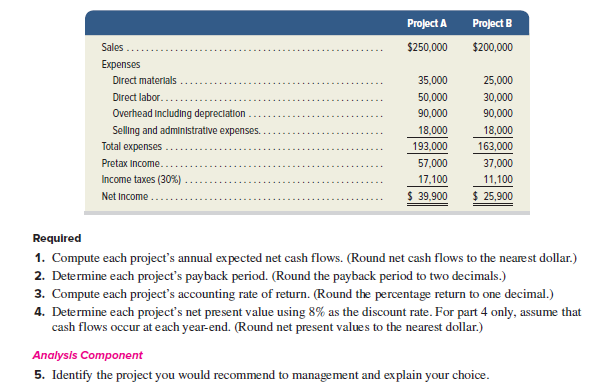Project A Project B Sales $250,000 $200,000 Expenses Direct materials 35,000 25,000 Direct labor.. 50,000 30,000 Overhead Including depreciation 90,000 90,000 Selling and administrative expenses. 18,000 18,000 Total expenses 193,000 163,000 Pretax Income. 57,000 37,000 Income taxes (30%) 17,100 11,100 Net Income $ 39,900 25,900 Required 1. Compute each project's annual expected net cash flows. (Round net cash flows to the nearest dollar.) 2. Determine each project's payback period. (Round the payback period to two decimals.) 3. Compute each project's accounting rate of return. (Round the percentage return to one decimal.) 4. Determine each project's net present value using 8% as the discount rate. For part 4 only, assume that cash flows occur at each year-end. (Round net present values to the nearest dollar.) Analysis Component 5. Identify the project you would recommend to management and explain your choice.
Project A Project B Sales $250,000 $200,000 Expenses Direct materials 35,000 25,000 Direct labor.. 50,000 30,000 Overhead Including depreciation 90,000 90,000 Selling and administrative expenses. 18,000 18,000 Total expenses 193,000 163,000 Pretax Income. 57,000 37,000 Income taxes (30%) 17,100 11,100 Net Income $ 39,900 25,900 Required 1. Compute each project's annual expected net cash flows. (Round net cash flows to the nearest dollar.) 2. Determine each project's payback period. (Round the payback period to two decimals.) 3. Compute each project's accounting rate of return. (Round the percentage return to one decimal.) 4. Determine each project's net present value using 8% as the discount rate. For part 4 only, assume that cash flows occur at each year-end. (Round net present values to the nearest dollar.) Analysis Component 5. Identify the project you would recommend to management and explain your choice.
Chapter2: Financial Statements, Cash Flow, And Taxes
Section: Chapter Questions
Problem 14SP
Related questions
Question
Aikman Company has an opportunity to invest in one of two projects. Project A requires a $240,000 investment for new machinery with a four-year life and no salvage value. Project B also requires a $240,000 investment for new machinery with a three-year life and no salvage value. The two projects yield
the following predicted annual results. The company uses straight-line

Transcribed Image Text:Project A
Project B
Sales
$250,000
$200,000
Expenses
Direct materials
35,000
25,000
Direct labor..
50,000
30,000
Overhead Including depreciation
90,000
90,000
Selling and administrative expenses.
18,000
18,000
Total expenses
193,000
163,000
Pretax Income.
57,000
37,000
Income taxes (30%)
17,100
11,100
Net Income
$ 39,900
25,900
Required
1. Compute each project's annual expected net cash flows. (Round net cash flows to the nearest dollar.)
2. Determine each project's payback period. (Round the payback period to two decimals.)
3. Compute each project's accounting rate of return. (Round the percentage return to one decimal.)
4. Determine each project's net present value using 8% as the discount rate. For part 4 only, assume that
cash flows occur at each year-end. (Round net present values to the nearest dollar.)
Analysis Component
5. Identify the project you would recommend to management and explain your choice.
Expert Solution
This question has been solved!
Explore an expertly crafted, step-by-step solution for a thorough understanding of key concepts.
This is a popular solution!
Trending now
This is a popular solution!
Step by step
Solved in 3 steps

Knowledge Booster
Learn more about
Need a deep-dive on the concept behind this application? Look no further. Learn more about this topic, accounting and related others by exploring similar questions and additional content below.Recommended textbooks for you

